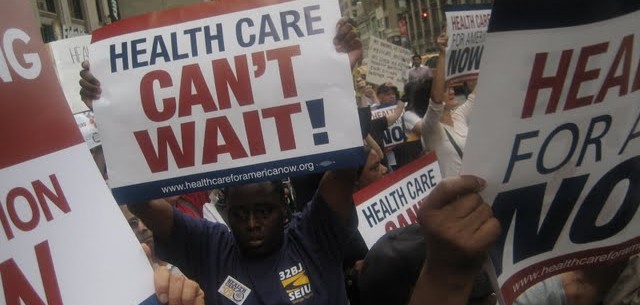As the New York State Legislature’s annual budget session draws to a close by the end of this month, advocates are corralling their forces to influence the negotiations between Governor Cuomo, the State Senate, and the State Assembly, and weighing in with their top policy and funding priorities.
The process began in late January with the Governor’s release of his proposed budget. The Legislature began its work in early February with a series of joint hearings throughout the month on various parts of the budget, hearing from and questioning the various commissioners and stakeholders, including advocates. The hearing on health provisions was held on February 2nd. In late February, the Governor released his 30-day amendments. In early March, working off the Governor’s proposals, each legislative chamber crafted their own “one-house” bills, which were each enacted by March 12. Conference committees were then appointed to publicly debate the differences with each other and the Governor, and 3-way negotiations began in private between the Governor, Senate, and Assembly leadership. A final agreement is expected by late March, with bills voted on by April 1st.
HEALTH CARE FOR ALL NEW YORK (HCFANY), a consumer health advocacy coalition focusing on all things related to Affordable Care Act (ACA) implementation, has identified the following issues of importance:
Funding for the “NY State of Health” health benefits exchange marketplace: As of the end of February, over 2.1 million New Yorkers have enrolled into insurance coverage through this new program since it opened in October 2013, either through Medicaid, Child Health Plus, or the new private “qualified health plans” (QHPs), far exceeding all predictions. 88% of them were previously uninsured, and 80% of those enrolling in private coverage were eligible for financial assistance either in the form of premium subsidies or cost-sharing reductions. In short, it’s proven a smashing success!
While the federal government has provided administrative funding for the first 2 years of its operations, this marketplace must be self-sustaining starting in 2016. Governor Cuomo has proposed a modest, broad-based assessment on all insurers in all markets to raise the needed funds, since it serves as the safety net for all uninsured New Yorkers and benefits the state’s entire health insurance system. The Assembly has agreed with the Governor, and added an important consumer protection that the assessment cannot be passed along to policyholders in their premiums, but rather, must come out of insurers’ windfall profits given all the new customers they now have. Surprisingly, the Senate did not include any funding mechanism for the marketplace in their one-house bill, saying they disagreed with the Governor’s approach but offering no alternative.
Funding for the “Community Health Advocates” (CHA) program: CHA is New York’s official consumer assistance program for health insurance, created under the ACA. It is comprised of a network of non-profits across the state who help people with all kinds of “post-enrollment” issues related to using health insurance, or accessing needed services if they are uninsured. CHA too has proven a smashing success, serving hundreds of thousands of people and saving them millions of dollars in total since it began in 2010. With now 2.1 million more New Yorkers gaining coverage, demand for CHA’s services has increased dramatically.
The federal government provided start-up funds for these state consumer assistance programs like CHA, but it ends as of this June. Governor Cuomo proposed to provide $2.5M to keep the program in operation. The Assembly raised that amount to $3M, but the Senate one-house bill did not include any funding. At its previous height of maximum federal funding, CHA operated at $5M/year, providing on-the-ground services in every county statewide, with an additional focus on serving small businesses as well as individual consumers. As federal funding diminished in the last couple of years, CHA had to scale back that effort. HCFANY is calling for the Governor and Legislature to restore CHA to the full $5M/year level so that it can return to its formerly-robust level of operations.
Funding for operating a new “Basic Health Program” (BHP): Under the ACA, states have the option to set up a BHP to provide very low-cost insurance coverage to the working poor who have too much income to qualify for Medicaid yet have difficulty affording the costs of purchasing and using private insurance. In last year’s budget agreement, a BHP was authorized, making New York only the second state to do so, and the Cuomo administration has proceeded with plans to set one up, with the goal of opening it for enrollment in January 2016. BHP coverage will be paid for by federal funds, but the administrative costs to operate it won’t. Governor Cuomo proposed to reallocate existing funding within the Department of Health’s budget to do so, and the Assembly agreed, but the Senate’s one-house bill repealed the whole program. Senate leaders are apparently worried that come 2017, with a new president and new Congress, the ACA and/or parts of it (such as funding for BHPs) could be repealed, leaving the state responsible for the entire cost of it.
Indigent care funding for hospitals: The ACA requires that federal “Disproportionate Share Hospital” (DSH) funding be directed to states with high levels of uninsurance who target these funds to hospitals that serve high numbers of Medicaid and uninsured patients. In 2012, New York revised its Indigent Care Pool (ICP) allocations to meet ACA requirements, but allowed hospitals a three-year transition period to conform. Now, Governor Cuomo proposed to provide an additional three-year transition period, and the Senate and Assembly agreed. It is unclear if the federal government will accept this further delay. HCFANY disagrees with this approach and urges that the ACA’s new system go into effect now so that hospitals that actually provide lots of indigent care receive the DSH funds they deserve, while others that don’t won’t get this funding any longer.
HCFANY also supports the Assembly’s proposal to reconvene the Medicaid Redesign Team Technical Assistance Committee to make recommendations to adjust ICP payments if New York’s DSH funding is reduced because of non-compliance. In addition, HCFANY supports a proposal from the Governor and Assembly to make the state’s “financial assistance compliance pool” permanent, and opposes the Senate proposal to eliminate it after 2016. This pool rewards hospitals that comply with the state’s hospital financial assistance law by providing low-income, uninsured patients with access to and help with enrolling in their financial assistance programs.
Private equity demonstration projects: Governor Cuomo proposes allowing a demonstration project that would allow private equity firms to invest in the restructuring of up to 5 financially-precarious hospitals across the state that operate in medically-underserved areas. The Senate raises the number of allowable hospitals to ten, while the Assembly opposes the whole idea outright. HCFANY agrees with the Assembly, and believes that an influx of private equity would inappropriately shift the incentives of these hospitals away from providing access to quality care, particularly low-income and uninsured patients, in favor of creating profits for investors, thereby draining overall financial resources that are desperately needed by these facilities.
MEDICAID MATTERS NEW YORK (MMNY), a lead consumer health advocacy coalition focusing on all things related to Medicaid and public insurance programs, has identified the following issues of importance:
New co-pays for some Medicaid patients: Governor Cuomo has proposed modest co-payments for Medicaid patients enrolled in managed care plans who have incomes above the poverty level (currently, about $16,000/year.) The Assembly has rejected this idea, and the Senate’s bill is unclear.
Preserve important consumer protections of “spousal and parental refusal” and “prescriber prevails”: Governor Cuomo has proposed to eliminate the rights of spouses and parents to hold back a given amount of family income and assets from being taken into consideration when being determined eligible for long-term care services under Medicaid, in lieu of having to divorce a spouse or give up custody of a child to the state. The Senate and Assembly have both rejected this idea, as they have for many years now when proposed by various Governors.
Governor Cuomo has also proposed to eliminate the right of patients enrolled in traditional fee-for-service Medicaid to access medicines not listed on the state’s Medicaid preferred drug list when they are prescribed by the patient’s doctor as the only suitable course of treatment in a particular situation. The Senate and Assembly have both rejected the Governor’s idea, as they have for many years now when proposed by various Governors.
Funding for “transitional immediate need Medicaid” services: Currently, New York offers Medicaid coverage for critically needed personal care and urgent medical care while a Medicaid determination is pending (which can take up to 45 days) because doing so can avoid unnecessary hospitalization and/or institutionalization of patients. Governor Cuomo has proposed to end such coverage. The Senate did not address the matter in its one-house bill, while Assembly proposes to continue access through allowing a “presumptive eligibility” determination.
Funding for the Independent Consumer Advocacy Network (ICAN): As New York proceeds to transform its entire Medicaid program into a “care coordination” approach across the board, it created ICAN within last year’s budget. ICAN’s mission is to assist people on Medicaid needing long-term care and other special services with the transition from the old fee-for-service system. This year, the Governor proposed a $5M allocation for the program, which the Assembly supported but the Senate did not address in its one-house bill.
Adopting a “Community First Choice” (CFC) option: CFC is a federal Medicaid funding initiative that allows states to more widely provide long-term care to people in their homes and communities rather than solely in institutions, and states that enact a CFC program receive an additional federal Medicaid funding. Governor Cuomo’s budget includes an exemption from the Nurse Practice Act for new “Advanced Home Health Aides”, thereby increasing the availability of personnel necessary to fully implement a CFC program, and enhancing federal approval of the state’s CFC proposal submitted in December 2013. The Governor’s budget also includes authorization to reinvest savings resulting from a CFC approach (estimated to be approximately $300 million annually) into initiatives that will further the state’s Olmstead Plan” to de-institutionalize as much long-term care as possible. The Assembly supports the Governor’s CFC proposals, while the Senate rejects them.
Capital funding for community-based entities: Governor Cuomo has proposed $1.4B in new capital funding for hospitals, yet none for community-based entities. As the state proceeds with its “Delivery System Reform Incentive Payment” (DSRIP) program under Medicaid and its broader “State Health Improvement Program” (SHIP), both of which emphasize and prioritize non-institutional, community-based care programs working in collaboration with hospitals, MMNY believes it is important that they too have access to capital funds. The Assembly directs $10M for community health centers, while the Senate adds $500M more and directs that capital allocations be available to all providers, to be determined in consultation with the Legislature.



